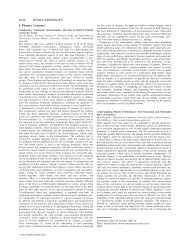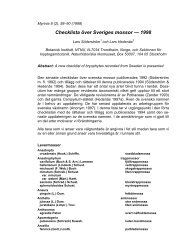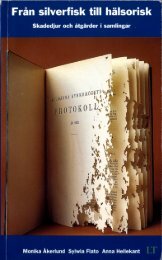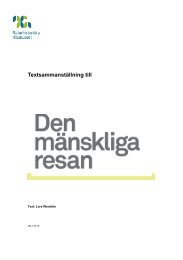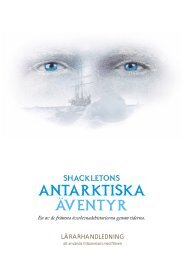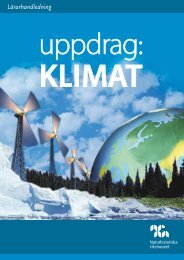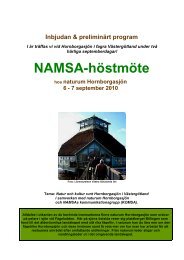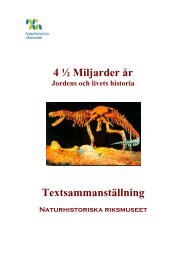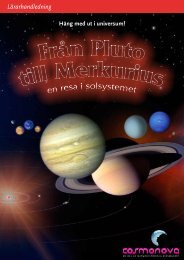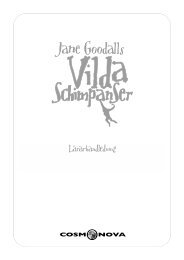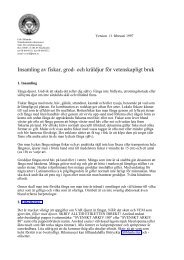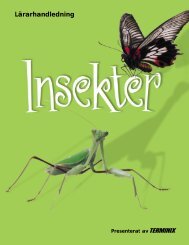Cosmic Collisions
Cosmic Collisions
Cosmic Collisions
Create successful ePaper yourself
Turn your PDF publications into a flip-book with our unique Google optimized e-Paper software.
Before Your Visit<br />
The following activities are designed to help you and your students make the most<br />
of your visit to the Space Show.<br />
Elementary and Middle school:<br />
Compete in the Moon Olympics: Have students “play sports on the Moon” at<br />
http://teacher.scholastic.com/activities/explorations/space/ (go to Level One) to learn<br />
about the effects of gravity on different worlds.<br />
Your place in space: Ask your students where they live. Then ask what they would add to<br />
that address if they traveled outside of your city or town, your state, and your country. How<br />
about if they traveled into space? Visit http://ology.amnh.org/astronomy/inspace/index.htm<br />
to hear a song about our cosmic address.<br />
Make your own sundial: Track the motions of the Sun across the sky the way people did in<br />
ancient civilizations. Plant a straight stick in the ground and, every hour, place a stone at<br />
the top of its shadow. Ask students to fi nd true north (the shortest shadow). Try again in<br />
three months and see what’s changed.<br />
Two faces of the same force: Demonstrate the interrelationship between electricity and<br />
magnetism for your students. They’ll see how to create a magnet using the fl ow of electricity<br />
through a wire, and, conversely, how a magnet driven through a coil can drive a current.<br />
Download the instructions at http://image.gsfc.nasa.gov/poetry/activity/l14.pdf.<br />
Middle and High school:<br />
<strong>Cosmic</strong> Calendar: Ask students to create a one-year calendar, and to fi t milestones of cosmic<br />
evolution onto it, so they can understand the scale of cosmic time. (For example, if the<br />
Big Bang occurs at midnight on January 1 st , the Sun is born on June 6 th , and humans don’t<br />
arrive until 11:58PM on December 31 st .) A timeline of cosmic events can be found at http://<br />
www.lpi.usra.edu/education/timeline/activity/.<br />
Activate an asteroid! Have students visit the Science Explorations: Journey into Space<br />
website at http://teacher.scholastic.com/activities/explorations/space/ (go to Level Two) to<br />
learn how the speed and angle at which an object approaches the Sun determines its fate.<br />
How much fuel does the Sun need? Ask students to calculate how many nuclear fusion<br />
reactions must occur per second to keep the Sun burning as brightly as it does. How much<br />
hydrogen is consumed in the process?<br />
http://www.amnh.org/education/resources/rfl /web/einsteinguide/activities/sun.html<br />
What if there were no Moon? Ask students to break up into teams and research how the<br />
Moon affects the Earth. (As an option, they could form three groups, one focusing on the<br />
geosphere, one on the atmosphere, and one on the hydrosphere.) After each group has<br />
presented its fi ndings to the class, brainstorm about what Earth would be like if there<br />
were no Moon. Then, have students compare their theories to what the experts think at<br />
http://www.newscientist.com/article.ns?id=dn4786.<br />
Explore the link between collisions and extinctions: There have been fi ve major extinctions<br />
on Earth: the End Cretaceous (K-T), the End Triassic, the Permian-Triassic, the Late<br />
Devonian, and the Ordovician-Silurian. Break your class into fi ve corresponding groups.<br />
Ask them to examine the evidence that experts use to determine which extinctions were<br />
related to impacts.<br />
This program can help you teach the<br />
National Science Education Content<br />
Standards listed below. Viewing the<br />
<strong>Cosmic</strong> <strong>Collisions</strong> Space Show will help<br />
students gain an understanding of:<br />
Elementary School<br />
S1b: motions of objects and materials;<br />
S1c: light, heat, electricity, and magnetism;<br />
S2c: change over time, such as evolution and<br />
fossil evidence depicting the great diversity of<br />
organisms over geologic history;<br />
S3b: objects in the sky;<br />
S3c: changes in Earth and sky;<br />
Middle School<br />
S1b: motions and forces, inertia;<br />
S1c: transfer of energy such as transformation<br />
of energy as heat; light, mechanical<br />
motion;<br />
S2e: the evolution and adaptation of<br />
living organisms;<br />
S3a: the structure of the Earth system;<br />
S3c: Earth in the Solar System;<br />
High School<br />
S1a: the structure of atoms;<br />
S1d: motions and forces, gravitational and<br />
electrical; magnetism;<br />
S1f: interactions of energy and matter;<br />
S3a: energy in the Earth system;<br />
S3c: origin and evolution of the Earth system;<br />
geologic time; evolution of the Solar System;<br />
S3d: the origin and evolution of the universe;<br />
nuclear reactions.<br />
Use this guide and online resources<br />
[http://www.amnh.org/resources/<br />
exhibitions/collisions] to plan your<br />
visit ahead of time. Give students<br />
directions before you arrive, since it<br />
can be hard to fi nd space or quiet to<br />
communicate with the group. Information<br />
about school visits is available<br />
at http://www.amnh.org/education/<br />
schools/.



